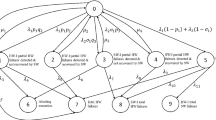Abstract
In today's era, the embedded system plays a very keen role in every field. However, the possibilities of errors occur in that system is so common, due to which the degradation of the system takes place or the system gets crash. The various types of errors that can be occurred in the embedded system are deliberated in its mathematical modelling. The interaction of the software with each system’s component and interaction of system software to application software are also considered. In this study, Markov process, Laplace Transformation and supplementary variable technique have been used to analyse the reliability measures of embedded system with its sensitivity and also discussed the effects of various failure rates on system performance. At last, a numerical example has been take to illustrate the results and their graphical representation are also given.







Similar content being viewed by others
References
Andrews JD, Moss TR (1993) Reliability and risk assessment, Longman Scientific and Technical
Billinton R, Wang P (1999) Teaching distribution system reliability evaluation using Monte Carlo simulation. IEEE Trans Power Syst 14(2):397–403
Cao X, Hu L, Li Z (2019) Reliability analysis of discrete-time series-parallel systems with uncertain parameters. J Ambient Intell Humaniz Comput 10(7):2657–2668
Dhillon BS, Yang N (1996) Reliability analysis of a repairable robot system. J Qual Maint Eng 2(2):30–37
Dhillon BS, Yang N (1993) Availability of a man-machine system with critical and non-critical human error. Microelectron Reliab 33(10):1511–1521
Gertsbakh IB, Shpungin Y (2016) Models of network reliability: analysis, combinatorics, and Monte Carlo. CRC Press
Goel LR, Gupta R, Rana VS (1993) Reliability analysis of a satellite-based computer communication network system. Microelectron Reliab 33(2):119–126
Goševa-Popstojanova K, Trivedi KS (2001) Architecture-based approach to reliability assessment of software systems. Perform Eval 45(2–3):179–204
Goyal N, Ram M (2014) Software development life cycle testing analysis: a reliability approach. Math Eng Sci Aerosp 5(3):313–329
Goyal N, Ram M (2018) Bi-directional system analysis under Copula-Coverage approach. Commun Stat Simul Comput 47(6):1831–1844
Goyal N, Ram M, Dua AK (2016) An approach to investigating reliability indices for tree topology network. Cybernet Syst Int J 47(7):570–584
Goyal N, Rawat S, Ram M (2017) Software reliability growth model for non-homogenous poisson process (NHPP) under agile process. Int J Appl Math Comput Sci 27(4):777–783
Henley EJ, Kumamoto H (1992) Probabilistic Risk Assessment. IEEE Press, New York
Kumaresan K, Ganeshkumar P (2020) Software reliability prediction model with realistic assumption using time series (S) ARIMA model. J Ambient Intell Human Compu 11:5561–5568
Liu H (1998) Reliability of a load-sharing k-out-of-n: G system: non-iid components with arbitrary distributions. IEEE Trans Reliab 47(3):279–284
Lyu MR (1996) Handbook of software reliability engineering, vol 3. IEEE Computer Society Press, CA
McCluskey EJ, Mitra S (2004) Fault tolerance. In: Tucker AB (ed) Computer science handbook, 2nd edn, Chapter 25. Chapman and Hall/CRC Press, London, UK
Musa JD, Okumoto K (1984) A logarithmic Poisson execution time model for software reliability measurement. In Proceedings of the 7th international conference on Software engineering 230–238
Narayanan V, Xie Y (2006) Reliability concerns in embedded system designs. Computer 39(1):118–120
NTSB (1997) Aircraft accident report, NTSB/AAR-97102. National Transportation Safety Board, Washington, DC
Pham H, Wang H (1996) Imperfect maintenance. Eur J Operation Res 94(3):425–438
Pham H (1992) Reliability analysis of a high voltage system with dependent failures and imperfect coverage. Reliab Eng Syst Saf 37(1):25–28
Qureshi ZH (2008) A review of accident modeling approaches for complex critical sociotechnical systems (No. DSTO-TR-2094). Defence Science and Technology Organisation Edinburgh (Australia) Command Control Communications and Intelligence Div
Rajaraman V (2010) Fundamentals of computers. PHI Learning Pvt. Ltd., Delhi
Ram M, Goyal N (2016) ATM network inspection under stochastic modelling. J Eng Sci Technol Rev 9(5):1–8
Ram M, Singh SB, Singh VV (2013) Stochastic analysis of a standby system with waiting repair strategy. IEEE Trans Syst Man Cybernet Syst 43(3):698–707
Reason J (1990) Human error. Cambridge University Press
Singh VV, Ram M, Rawal DK (2013) Cost analysis of an engineering system involving subsystems in a series configuration. IEEE Trans Autom Sci Eng 10(4):1124–1130
Soi IM, Aggarwal KK (1980) On human reliability trends in digital communication systems. Microelectron Reliab 20(6):823–830
Teng X, Pham H, Jeske DR (2006) Reliability modeling of hardware and software interactions, and their applications. IEEE Trans Reliab 55(4):571–577
Wattanapongsakorn N, Levitan SP (2004) Reliability optimization models for embedded systems with multiple applications. IEEE Trans Reliab 53(3):406–416
Zeng Y, Xing L, Zhang Q, Jia X (2019) An analytical method for reliability analysis of hardware-software co-design system. Qual Reliab Eng Int 35(1):165–178
Zhang X, Mahadevan S (2017) A game theoretic approach to network reliability assessment. IEEE Trans Reliab 66(3):875–892
Zhu M, Pham H (2019) A novel system reliability modeling of hardware, software, and interactions of hardware and software. Mathematics 7(11):1049
Funding
Funding is not taken for this work from any agency.
Author information
Authors and Affiliations
Corresponding author
Ethics declarations
Conflict of interest
There are no conflict of interest.
Additional information
Publisher's Note
Springer Nature remains neutral with regard to jurisdictional claims in published maps and institutional affiliations.
Rights and permissions
About this article
Cite this article
Goyal, N., Roy, V.K. & Ram, M. Mathematical modelling of embedded systems under network failures. Int J Syst Assur Eng Manag 13, 604–614 (2022). https://doi.org/10.1007/s13198-021-01313-6
Received:
Revised:
Accepted:
Published:
Issue Date:
DOI: https://doi.org/10.1007/s13198-021-01313-6




